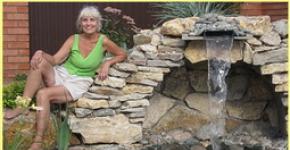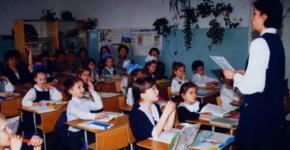The exposition of "little mischievous". Getting ready for a concise presentation
I. Organizational moment.
II. Setting a training goal.
- Today in the lesson we continue to work with texts about animals. We will learn to make a plan of the text and retell according to the plan, we will analyze difficult words and write a statement. I wish you all success.
Emotional perception of the text.
(Watching the movie "How Beautiful the Animal World is!")
- The animal world is amazing, wonderful and diverse. Cubs are often clumsy and funny, sometimes funny and always touching.
- Guess the riddle and find out which animal will be mentioned in the text (slide 3).
The riddle.
Tumble the beast goes,
For raspberries and honey.
He loves sweets very much.
And when autumn comes
Crawls into the pit until spring
Where he sleeps and dreams.
What do you know about bears? (students answer)
Did you know? (slide 4)
-Heroes of our text are cubs. (slide 5)
III. Reading text by teacher.
The text is written on a blackboard (slide 7, 8) and in each student’s task books.
IY. Analysis of the content of the text.
Definition of the topic and main idea of \u200b\u200bthe text.
-Who is the text spoken about?
- What is being said about them?
- How can I title the text? Hyperlink to hidden slide 9, then to slide 10 (students offer different options; the “Little mischievous” option; when you stop at this option, the name appears when you click) slide11 When you click on the name, we’ll go to the hidden slide 9 Hidden slide hyperlink 9
Determining the number of parts in the text.
- How many parts in the text?
-Reread 1 part and find the words that suggest what it says? (They brought a teddy bear) (slide 9- when clicked, the name of 1 part appears)
- Re-read part 2 and find words that suggest what is being said in part 2 of the text? (They came up with entertainment.) (Slide 10 - a similar appearance of the name of 2 parts) then to slide 10
What person is the story from? Prove it.
- Observe the changing tenses of the verbs. What form of time helps us to become witnesses of Mishka’s actions? (underlining of verbs in exercise books)
What verbs are used at the same time?
And what other forms of verbs are in the text?
What does a writer call his heroes?
Do all sentences have these words? Which not? Why did the author miss them?
- Pay attention to selected alliances. Do they help to more closely combine proposals with each other?
Y. Physical Fitness (Slide 12)
The work includes a musical physical education in which children perform physical and dance exercises to sounding music. It is carried out taking into account age, individual characteristics of the class and their performance
Yi Spelling preparation.
Slide 13. On the screen, text with missing letters. Pupils name the missing letter, explain the choice of letters. The right letters appear at the click of the mouse. Pupils in taskbooks emphasize “dangerous” places.
Accepted if the hunters from the forest two m _dv_zhat. Little ones were! But by v_ dream p_drosli and began to be naughty.
Once in front of my very nose, a brick from the roofs_was poured. I look at the roof and what I see. Bears came up with entertainment. S_dyat and from the pipe on the brick _tvalyat. He crawls on the roof and rustles. And m_dv_zhatam like. One even stuck out his tongue with pleasure.
These are the mischievous!
YII. Read and retell text (slide 14)
-Reread the text and imagine the painted picture. Tell the text from 1 person, imagining yourself to be a witness to this story.
YIII. Writing a statement.
You tried very hard, did a wonderful job, prepared. I am sure that you will get very good retelling.
When you write, do not forget to work as editors and proofreaders.
While writing the presentation on the screen (slide 15), the outline of the presentation and the words for reference remain.
IX. Self test.
After writing the presentation, students check their text, if necessary, make changes and corrections with a simple pencil.
X. Summary and reflection of activities. (slide 16)
- Guys, what did you learn in the lesson?
-Is the text interesting?
Homework. Think up and write down what else the funny case with little cubs could have happened.
Lebedeva Antonina Pavlovna
Studying literature at school is very exciting and informative. It is on this subject that we get acquainted with the work of great authors, with the masterpieces of Russian and foreign literature. But there are also difficulties in learning. Teachers demand to study poems, write essays and others Today we will analyze what the exposition is, learn how to write it correctly, and also consider some tricks that will greatly facilitate your work.
We begin with the very concept of what the statement is. We give a real example of the work of a fifth grader and analyze all the mistakes that should not be made. Let's try to write the perfect presentation, taking into account the amendments of the teacher. We propose to proceed immediately.
What is it?
So what is the statement? This is one of the types of creative work in literature. Teachers very often use presentation to control student knowledge. To get a high mark for a quarter, you need to try hard and bring the quality of your creative work to perfect condition.
What is the meaning of the presentation? You read, or you read a small text, usually from classical literature. Next, you need to analyze what you have read or heard and write a short retelling, while retaining the main idea of \u200b\u200bthe work or its passage. There is also such a kind of work as verbal presentation. What is it used for? The presentation (oral and written) allows you to build spelling and styling skills, which is very necessary for survival in our society. After graduation, the student should be a formed personality, who can beautifully and smoothly express his thoughts, has certain goals in life. 
First, the teacher reads the text. The student’s task is to record the necessary data (numbers, names, sequence of events, and so on). The teacher gives some time for writing a draft version, the student must leave empty places where necessary (forgot something, did not have time to write down). Further, the text is read again. This is the last chance to add something to your presentation. The draft version is supplemented, spelling, punctuation, and stylistics are checked. The next step is to write the final version.
Often there is such a practice: together with the presentation, it is necessary to complete a small creative task (to head the text, write a detailed conclusion, that is, your attitude to the problem, supplement an unfinished thought, and so on).
Plan
When the teacher reads the text for the first time, some sketches are necessary. It is very important at this stage to formulate a plan of presentation. One part is a separate paragraph. You must carefully listen and divide the entire text into semantic parts. Write them down, and you get a plan. It allows you to write a beautiful and harmonious text, not to get confused in the sequence of events occurring in the text.
Spelling
What is the presentation and why is it used, we figured out, and now we will move on to a brief memo to help you write a quality work:
- Listen carefully to the text, identify the main problem.
- At the first reading, try to make small notes (plan, names, dates, vivid expressions that need to be included in the presentation).
- Check with the teacher for the meaning of words that you don’t understand.
- When re-reading, make a detailed plan.
- Next is the work on the text, remove items from the plan that do not carry a semantic load.
- Write a draft, check spelling, punctuation and style.
- Start writing the final version.

Example
Let us give an example of class 5. Here we also consider errors.
"They put a good new door in the hut, everyone praised it."
That's right: they put a new door in the hut.
"She did not miss the winter cold and the summer heat, they stopped talking about her because there was nothing to reproach her with."
That's right: it closed well and opened, there was nothing to reproach her with.
"But everyone talked a lot about frames, and how could you not talk about them when they creaked, passed the frost and swelled."
That's right: everyone was talking about frames because they were bad.
The principle of writing a concise statement even in this small passage is clear. It is necessary to exclude information that does not carry a meaning, remove repetitions and descriptions.
Good afternoon, my dear readers. In elementary school, many tasks are aimed at developing speech, developing skills to transmit what was heard, while preserving the style. Therefore, in the 2nd grade, children begin to slowly train creatively.
In order to do this correctly and beautifully, you need to understand what the presentation is and how to write it.
Lesson plan:
What does it mean to state and how should it be?
To begin with, in its essence, exposition is a retelling. This type of creative task in the Russian language and literature is used by teachers not only in elementary grades, but also in high school, in order to control students' knowledge. In short, the meaning of it is to read or hear, analyze what has been read or heard, and state it in your own words, preserving the main idea.
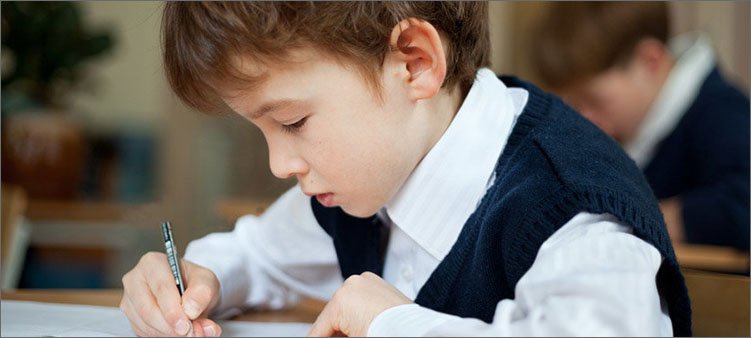
Why do you need to be able to spell out? Well, first of all, it's an excellent memory training. Secondly, the ability to retell forms the spelling and style, teaches to expound not only correctly in meaning, but to do it eloquently and smoothly.
Usually, teachers select literary works for presentation, but texts can be more difficult to find, for example, from scientific and journalistic works. If someone is sure that the initial test for further retelling should be read out independently or heard from the teacher, then this is a little bit wrong. Writings are made both on dramatic sound recordings, and on filmstrips, even on films and performances. So this is really creative work.
In order not to confuse the exposition with the essay, it is important for the child to explain the difference in the concepts of “expound” and “compose”.
So, we state what we hear, see, understand and remember. Therefore, in the presentation it is important to focus on the sequence and details. You can only compose your own, conveying your thoughts and feelings on a particular topic. There is no opinion of another author, his own judgments are proved.
It is believed that the presentation is less time-consuming and difficult, since nothing needs to be invented, everything is ready-made. But this is a mistake. It is difficult for many children to reproduce a foreign language and stylist, because in such cases they tend to remember verbatim, without understanding the meaning of what is not right.

The statement has requirements that are imposed on it by a school test of knowledge. In addition to the fact that there should be no spelling mistakes or punctuation, children should be able to:
- understand the text, delve into the main idea and build a sequence of events,
- apply style and speech correctly when retelling,
- to memorize the facts and state them in the right order,
- make out everything with a beginning and a finished end,
- improve your retelling while preserving the style and main idea.
A lot, right? Good and hone skills!
These are general requirements at school for everyone, regardless of what type of presentation is given, and there are several of these types.
How can I retell?
In the 1st grade, students use one type of presentation - oral. At the same time, they can retell close to the text or transmit a summary, on behalf of the author or on their own behalf.
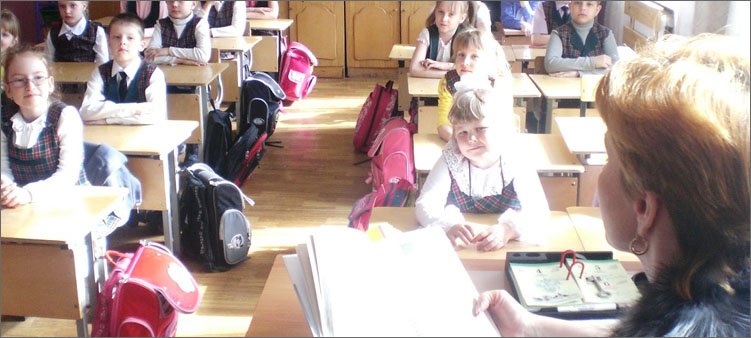
Students begin to practice writing at the Russian language lessons in grade 2, for which they select small tests in volume, 30-45 words each.
In the 3rd grade, new elements are introduced, and the children are already getting acquainted with the main types of presentation "in full."
- Details should preserve the consistency and style of the author, details, facts, even phrases. This type is most often used in elementary school, because it fixes the entire contents of the text in memory.
- Compressed retells the content of the text briefly, only the most important, conveying the meaning without details. It is important to keep the main idea of \u200b\u200bthe author, some important details and style. By the way, a summary is the result of lengthy training, not everyone gets it right the first time.
- Selective conveys only part of the text, a specific topic. For example, from the story about the forest inhabitants, the task is given to remember only about the fox and only about it, darling, not about the hare and the bear, to expound in the work.
But that is not all!

According to the speech that needs to be used in the work, the presentations are also divided into several types.
- Narratives maintain consistency and main circumstances. This is the simplest type of written retelling, where they write in an artistic style about the lives of people and animals, about incidents. The main thing here is informativeness.
- Descriptive is more complicated, and not only for schoolchildren, even for students. They require the use of eloquence in describing a person, object, phenomenon. For students, such statements seem boring, since descriptive work requires a large vocabulary and the ability to use synonyms, see hidden details, and not everyone can.
- The reasoning is aimed at catching the main points and bringing them to the reader with obligatory own reasoning, with elements. Such a task is given in high school, so that you have everything ahead.
- Often, expositions can be combined, that is, when a reasoning or description is present in the narrative, elements of reasoning are introduced into the description.
We have decided on the types of statements and requirements. Well here, as easy as shelling pears! But how would you learn to listen in such a way, sit in front of a blank sheet, and the speech poured in calligraphic handwriting in the right direction, with details and facts?
Learning to write a presentation
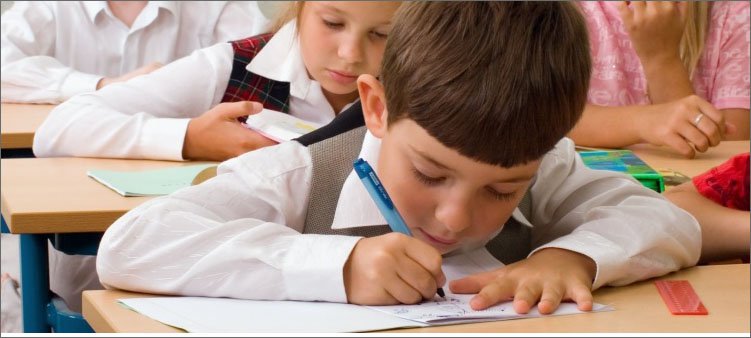
The school has a whole technique on how to write statements. It boils down to the fact that the teacher is two, and in elementary school he reads the text for retelling even three times. At first he does it slowly, with stops in the right places, which need special attention. The second time the text is read more fluently.
While the teacher is reading, children can mark important information in a draft, and then draw up a plan and write their own creative work according to the plan. And now at each point we dwell in more detail.
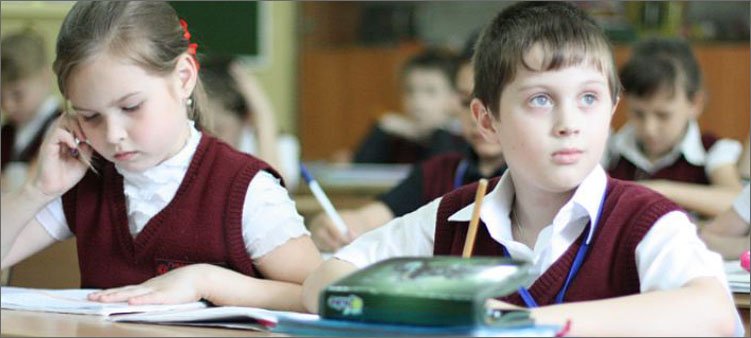
That's how everything seems to be simple, but in practice sometimes it’s not very. But do not despair, you know that "patience and work ...". So train at home, and by the time you write the final exam, your child will eloquently present works of any complexity!
On this, I say goodbye to you in anticipation of advice on how to quickly teach your child how to write statements.
Subscribe to blog news to keep abreast of school events and join to our VKontakte group)
Good luck to you!
Evgenia Klimkovich.
Text№ 1
How good it is in the summer in the countryside! The impenetrable forests stand green, shady and cool. Thousands of diverse voices of songbirds are heard in the thicket. Children in the morning run away to the forest to pick mushrooms and berries. Then they come across a red boletus, then a white boletus, or even a simple russula. Red and juicy strawberries, fragrant raspberries, blueberries, black currants, sour lingonberries - all these ruddy berries alternately pull the children into the forest and into the garden. And in the orchards trees faded: apple trees, pears and plums, and small fruits appeared. They will only ripen in the fall. The meadows were covered with high green grass, dotted with thousands of flowers. It is time for haymaking. No sooner had the haying moved, it was time to go to the golden cornfield. The rye of the desire-body, rang out, became heavy, ripened; oats began to curl, wheat dressed in golden brocade, buckwheat turned brown, peas lay in curls. In the gardens, some vegetables are replaced by others. Earlier than others, lettuce and radish ripen, followed by radish, carrots, beans and peas, later they start digging potatoes. Cabbage coagulates only in early September.
In the summer, everyone has fun and expanse: to man, and to the beast, and to the bird, and to the insect. City residents flee from dusty, stuffy cities, some to the village, some to the cottage to breathe fresh air and stock up on health. (192 words)
Compressed Optiontext number 1
How good it is in the summer in the countryside! The impenetrable forests stand green, shady and cool. Thousands of diverse voices of songbirds are heard in the thicket. Children in the morning run away to the forest to pick mushrooms and berries. And in the gardens the trees faded and the fruits appeared. They will only ripen in the fall. The meadows were covered with high green grass, dotted with thousands of flowers. It is time for haymaking. No sooner had the haying moved, it was time to go to the golden cornfield. Cereals ripened, ripened. In the gardens, some vegetables are replaced by others.
In summer, all living beings have fun and expanse. Urban residents flee from dusty, stuffy cities, some to the village, some to the cottage to breathe fresh air and stock up on health. (102 words)
Text№ 2
Palekh silhouette
Smokes from the chimneys, crunch of the first snow, geese, chickens in the gardensfront gardens, sparrows in the hot spot... The village is like a village. There were many of these in non-chernozem regions. Almost everyone, in addition to working in the fields, also traded something else. Some were fed by a cab, making wooden dishes, weaving baskets, pottery, making carts andsledges, children's toys, barrels, matting, tar, coal ...
Palekh fed on a noble trade: from time immemorial, icon painters lived here. And, it would seem, the local craftsman in the first place should have been idle after the revolution. This did not happen: after all, the artist’s hand painted iconic faces, and the turn of life naturally gave direction to the new craft. Palekh found a second wind, deep and healthy: caskets began to be painted here.
Caskets of masters-paleshans are known to all, and there is no need to talk about the ability to turn a small box into a jewel with the finest means. Folk tales, pictures of everyday life,native nature, moments of our history - the Palestinian knows how to look at everything through the magic glass of native craftsmanship.
From afar it seems: the village itself should also look like an original painting, everything in it should look fabulous, unusual. No, everything is ordinary, everything is earthly! Snowy meadow near the river; ice on the river rings from an abandoned stick just like everywhere he rings; mountain ash and willow are the same as in the village next door. AND woodpile of firewood near houses, and linen on a rope petrified by frost, and a gander, slowly crossing the road, - everything is familiar to us. And not a firebird at all, but magpie flashed with a black and white feather at someone's trumpet. In short, ordinary life, ordinary colors and sounds nourish the local master. It all depends only on what kind of eyes a person looks at the world, how sensitive his heart is and how obedient, skillful is a hand that creates out of the ordinary amazing, fabulous beauty.
Porches, carved platbands _on the windows, well cranesslender white bell tower This one fire Tower, this old mill on the hill - everything here is pleasing to the eye and helps to arouse feelings, traces of which we see on the black lacquer of famous caskets.
Years and decades pass, the way of life in Russia is changing, the economy and politics in the country are being renewed, and Palekh’s art is still as old, as bewitching and precious. One casket is sometimes more expensive than gold rings or earrings. Palekh caskets are presented for anniversaries, during festivities. As souvenirs they are bought by foreigners coming to Russia, because nowhere else in the world can you buy such beautiful caskets. (386 words)
Compressed Text Option№ 2
Palekh silhouette
World famous painted caskets are born in an ordinary village ... Half an hour drive from the city of Shui, and here it is - Palekh. Familiar rural paintings. There were many such villages in the non-chernozem regions. Almost everyone, in addition to working in the fields, was engaged in some other crafts.
Palekh fed on a noble trade: from time immemorial, icon painters lived here. And, it would seem, the local craftsman first should have been idle after the revolution. But this did not happen. Palekh found a second wind: caskets began to be painted here.
Caskets of masters-paleshans are known to all, and there is no need to talk about the ability to turn a small box into a jewel with the finest means. On any side of life the Palestinian knows how to look through the magic glass of native craftsmanship.
From afar it seems: the village itself should also look like an original painting, everything in it should look fabulous, unusual. No, everything earthly! Usual life , ordinary paints and soundsnourish the local master. It all depends on how the person looks at the world with his eyes, how sensitive his heart is and how obedient, skillful a hand is, creating from the ordinary amazing, fabulous beauty.
But, of course, the Palestinian people are trying to decorate their village. Rural buildings pleasing to the eye and help arouse feelings, traces of which we see on the black lacquer of the famous caskets.
Years and decades pass, the way of life in Russia is changing, the economy and politics in the country are being renewed, and Palekh’s art is still as old, as bewitching and precious. One casket is sometimes more expensive than gold rings or earrings. Palekh caskets are presented on celebration days. As souvenirs they are bought by foreigners coming to Russia, because nowhere else in the world can you buy such beautiful caskets. (241 words)

